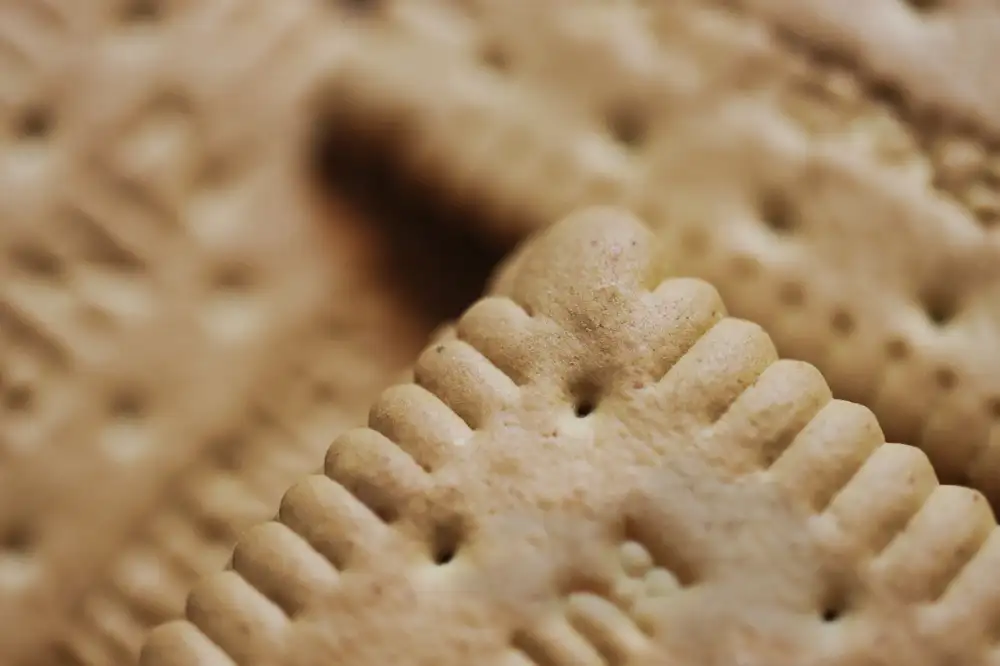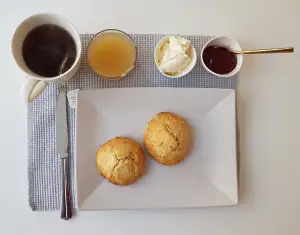Mastering the Art of Shortbread: A Step-by-Step Guide to Making Delicious Cookies

- Gathering the Ingredients for Shortbread
- Step-by-Step Instructions for Making Shortbread
- 1. Preparing the Dough
- 2. Shaping and Cutting the Shortbread
- 3. Baking the Shortbread to Perfection
- Tips and Tricks for Perfect Shortbread
- Variations and Additions to Elevate Your Shortbread
- Serving and Storing Shortbread
Shortbread is a classic cookie recipe that has been enjoyed for centuries. Its buttery, crumbly texture and rich flavor make it a favorite among both bakers and cookie lovers alike. With just a few simple ingredients, you can create a batch of delicious shortbread cookies that will impress your friends and family. In this article, we will guide you through the process of mastering the art of shortbread, from gathering the ingredients to serving and storing the finished product. So let's get started on this delectable journey to culinary excellence!
Gathering the Ingredients for Shortbread
Before you embark on your journey to mastering the art of shortbread, it is essential to gather all the necessary ingredients. The beauty of shortbread lies in its simplicity, and you will find that most of these ingredients are already staples in your pantry.
To make a basic shortbread recipe, you will need:
1. Butter: Choose unsalted butter for a purer taste. Make sure it is at room temperature so that it can be easily incorporated into the dough.
2. Flour: All-purpose flour works best for shortbread as it provides the right texture and structure.
3. Sugar: Granulated sugar is commonly used in traditional shortbread recipes. However, you can experiment with different types of sugars like powdered or brown sugar for added flavor.
4. Salt: A pinch of salt enhances the overall taste and balances out the sweetness.
5. Flavorings (optional): While classic shortbread relies solely on buttery goodness, you can add a touch of vanilla extract or other flavorings like lemon zest or almond extract to elevate the taste.
Ensure that your ingredients are fresh and high-quality as they directly impact the final result. With these simple yet essential ingredients ready, you are now prepared to move on to the next step in creating delectable shortbread cookies.
Step-by-Step Instructions for Making Shortbread
3.1. Preparing the Dough
- In a large mixing bowl, cream together 1 cup of unsalted butter and ½ cup of powdered sugar until light and fluffy.
- Gradually add 2 cups of all-purpose flour, mixing well after each addition.
- Optional: Add a pinch of salt for a savory twist or 1 teaspoon of vanilla extract for added flavor.
3.2. Shaping and Cutting the Shortbread
- Gather the dough into a ball and flatten it into a disk shape.
- Place the dough between two sheets of parchment paper and roll it out to your desired thickness (usually about ¼ inch).
- Use cookie cutters to cut out shapes or simply slice the dough into squares or rectangles.
3.3. Baking the Shortbread to Perfection
- Preheat your oven to 325°F (160°C) and line a baking sheet with parchment paper.
- Transfer the cut-out shortbread onto the prepared baking sheet, leaving some space between each piece.
- Bake for approximately 12-15 minutes, or until the edges are golden brown.
- Remove from the oven and let them cool on a wire rack before serving.
These simple steps will ensure that you achieve perfectly tender and buttery shortbread cookies every time.
1. Preparing the Dough
Preparing the Dough:
To begin making delicious shortbread, you will need to gather the necessary ingredients and prepare the dough. The key to a perfect shortbread lies in its simplicity, so make sure to follow these steps carefully.
First, gather 2 cups of all-purpose flour, 1 cup of unsalted butter (at room temperature), and 1/2 cup of granulated sugar. These three basic ingredients are the foundation of any good shortbread recipe.
Next, in a large mixing bowl, cream together the butter and sugar until light and fluffy. This can be done using an electric mixer or by hand with a wooden spoon. The creaming process incorporates air into the mixture, resulting in a tender and crumbly texture.
Once the butter and sugar are well combined, gradually add in the flour. Mix until just incorporated; overmixing can lead to tough cookies. The dough should come together easily and not be too sticky. If it feels too dry, you can add a tablespoon of milk or water at a time until it reaches the right consistency.
After preparing the dough, cover it with plastic wrap and refrigerate for at least 30 minutes. Chilling allows the flavors to meld together and makes it easier to handle when shaping later on.
Now that you have prepared the dough for your shortbread cookies, you are ready to move on to shaping and cutting them into delightful shapes before baking them to perfection.
2. Shaping and Cutting the Shortbread
Shaping and Cutting the Shortbread
Once you have prepared the dough, it's time to shape and cut your shortbread. This step is crucial as it determines the final appearance of your cookies. Here's how to do it:
1. Dust a clean surface with flour to prevent the dough from sticking. Place the dough onto the floured surface.
2. Using a rolling pin, gently roll out the dough to your desired thickness. For traditional shortbread, aim for about 1/4 inch thickness.
3. Now comes the fun part - choosing a shape for your shortbread! You can use cookie cutters in various shapes such as circles, hearts, or stars. Alternatively, you can simply slice the dough into squares or rectangles using a sharp knife.
4. Carefully transfer the shaped shortbread onto a baking sheet lined with parchment paper. Leave some space between each cookie to allow for even baking.
5. If desired, you can add decorative touches by using a fork to create patterns on top of each cookie or sprinkle some sugar on them for extra sweetness.
6. Before placing the baking sheet in the oven, refrigerate it for about 15 minutes. This helps firm up the dough and maintain its shape during baking.
Now that you have shaped and cut your shortbread, it's time to bake them to perfection!
3. Baking the Shortbread to Perfection
Once you have shaped and cut your shortbread dough, it's time to bake it to golden perfection. Preheat your oven to 325°F (160°C) and line a baking sheet with parchment paper.
Place the shortbread rounds or shapes onto the prepared baking sheet, leaving a small space between each one. This will allow for even baking and prevent them from sticking together.
Bake the shortbread in the preheated oven for about 15-20 minutes, or until they are lightly golden around the edges. Keep a close eye on them as they can quickly go from perfectly baked to overdone.
Remove the baking sheet from the oven and let the shortbread cool completely on a wire rack before handling. They will continue to firm up as they cool, resulting in that signature crumbly texture.
Remember, every oven is different, so adjust the baking time accordingly. If you prefer a softer shortbread, reduce the baking time slightly. For a crispier texture, extend the baking time by a few minutes.
By following these simple steps and keeping an eye on your shortbread while it bakes, you'll be able to achieve perfectly baked cookies every time. Get ready to enjoy their buttery goodness!
Stay tuned for more tips and tricks in our next section: "Tips and Tricks for Perfect Shortbread".
Tips and Tricks for Perfect Shortbread
1. Use high-quality butter: The key to a rich and buttery shortbread is using the best quality butter you can find. Look for butter with a high fat content, as this will give your cookies a tender texture.
2. Chill the dough: After preparing the dough, it's important to chill it in the refrigerator for at least 30 minutes before shaping and cutting. This helps solidify the butter and prevents spreading during baking.
3. Don't overmix: When combining the ingredients, be careful not to overmix the dough. Overmixing can lead to tough cookies instead of delicate, crumbly shortbread.
4. Use powdered sugar: Instead of granulated sugar, opt for powdered sugar in your shortbread recipe. Powdered sugar adds a smoother texture and helps create that melt-in-your-mouth consistency.
5. Experiment with flavors: While traditional shortbread is delicious on its own, don't be afraid to experiment with different flavors. Add a teaspoon of vanilla extract or try incorporating citrus zest, spices like cinnamon or cardamom, or even chopped nuts for added depth of flavor.
6. Use parchment paper: To prevent sticking and ensure easy removal from the baking sheet, line it with parchment paper before placing your shaped shortbread on top.
7. Monitor baking time closely: Shortbread can easily go from perfectly golden to overbaked in just a few minutes. Keep a close eye on your cookies while they're in the oven and remove them as soon as they start turning light golden around the edges.
By following these tips and tricks, you'll be well on your way to mastering the art of perfect shortbread every time you bake them!
Variations and Additions to Elevate Your Shortbread
While classic shortbread is undeniably delicious on its own, there are countless variations and additions that can take this humble cookie to new heights. Here are a few ideas to inspire your creativity in the kitchen:
1. Citrus Zest: Add a burst of flavor by incorporating the zest of lemons, oranges, or limes into your shortbread dough. The bright citrus notes will add a refreshing twist to the buttery richness.
2. Chocolate Drizzle: For all the chocoholics out there, drizzling melted chocolate over your baked shortbread can create a decadent treat. Use dark, milk, or white chocolate depending on your preference.
3. Nutty Delights: Add some crunch and depth of flavor by mixing chopped nuts into your dough. Almonds, pecans, or walnuts work particularly well with the buttery texture of shortbread.
4. Spiced Sensations: Experiment with spices like cinnamon, nutmeg, or cardamom to infuse your shortbread with warm and aromatic flavors. These spices can complement both sweet and savory variations.
5. Dried Fruit Medley: Enhance the sweetness and texture of your shortbread by adding dried fruits such as cranberries, cherries, apricots, or raisins. Chop them finely before incorporating them into the dough for an even distribution.
Remember to adjust the quantities accordingly when adding these variations to ensure the perfect balance of flavors in your shortbread cookies. Don't be afraid to get creative and try out different combinations – you might just stumble upon a new favorite!
By experimenting with these additions and variations, you can elevate your shortbread from a simple cookie to a gourmet delight that will impress friends and family alike. So go ahead and unleash your culinary imagination while mastering the art of shortbread!
Serving and Storing Shortbread
Once your shortbread has cooled completely, it is ready to be served and enjoyed. The rich, buttery flavor of the cookies pairs perfectly with a cup of tea or coffee. Serve them on a platter or in a decorative tin for an elegant presentation.
To store your shortbread, place them in an airtight container at room temperature. They will stay fresh for up to two weeks. If you live in a humid climate, you may want to add a piece of parchment paper between each layer to prevent them from sticking together.
Shortbread also freezes well, so if you have leftovers or want to make a batch ahead of time, simply wrap them tightly in plastic wrap and place them in the freezer. When you're ready to enjoy them, let them thaw at room temperature for about 30 minutes before serving.
Remember, shortbread is best enjoyed within a few days of baking when they are at their freshest. So don't hesitate to indulge yourself and share these delicious cookies with family and friends.
In conclusion, mastering the art of shortbread is a delightful journey that will reward you with delicious cookies. By following this step-by-step guide and using high-quality ingredients, you can create shortbread that is buttery, crumbly, and simply irresistible.
Remember to gather all the necessary ingredients before starting and follow the instructions carefully. Preparing the dough requires patience and precision, while shaping and cutting it allows for creativity. Baking the shortbread to perfection ensures a golden brown color and a melt-in-your-mouth texture.
To achieve perfect shortbread every time, keep in mind some tips and tricks such as chilling the dough before baking and using a sharp knife for clean cuts. Additionally, don't be afraid to experiment with variations and additions like citrus zest or chocolate chips to elevate your shortbread to new heights.
When it comes to serving and storing your homemade shortbread, consider presenting them on a beautiful platter or packaging them as gifts. Shortbread can be enjoyed on its own or paired with tea or coffee for a delightful treat.
In summary, mastering the art of shortbread requires practice, attention to detail, and a love for baking. With dedication and creativity, you can create mouthwatering shortbread that will impress family and friends alike. So roll up your sleeves, gather your ingredients, and embark on this delicious culinary adventure today!
Published: 20. 11. 2023
Category: Food



